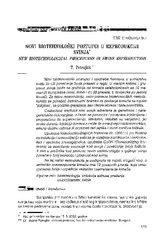Приказ основних података о документу
New biotechnological procedures in swine reproduction
Novi biotehnolopki postupci u reprodukciji svinja
| dc.creator | Petrujkić, Tihomir | |
| dc.date.accessioned | 2020-12-17T08:11:13Z | |
| dc.date.available | 2020-12-17T08:11:13Z | |
| dc.date.issued | 2002 | |
| dc.identifier.issn | 0350-2457 | |
| dc.identifier.uri | https://doaj.org/article/4c21b658a57d4adeafb4ef844ec4051c | |
| dc.identifier.uri | https://vet-erinar.vet.bg.ac.rs/handle/123456789/1939 | |
| dc.description.abstract | New biotechnological procedures and the use of hormones in swine breeding are aimed at increasing the number of piglets in the litter. In small herds and groups, selected sows with 16 mammary complexes (tits) can yield up to 32 piglets, or porkers, per year per sow. In order to achieve such reproduction results, special, individual stalls for sow deliveries are used, in addition to biotechnological methods, with a warm core and floor heating, phased diet and clean facilities. The ovulation value in swine is determined by their genetic and paragenetic effects, and it is often provoked and increased with injections and preparations for superovulation. However, the results vary, since any administration of hormone injecions can reduce the reproductive cycle, shorten the duration of estrus, or disrupt the work of ovaries and create cystic follicles. The use of follicle-stimulating hormones in quantities up to 1000 IU per animal for the induction and synchronization of estrus has become customary for sows and gilts, as well as the use of prostaglandins, the use of GnRH for increasing ovulation in swine and increasing the number of follicles >4 mm in diameter in the implementation of new biotechnologies in swine breeding, increases the number of ovulations and fertility in swine. In this way, reproduction is raised to the highest possible level, and artificial insemination of sows has 12 separate rules which enable better and more successful artificial insemination of sows. | en |
| dc.description.abstract | Novi biotehnološki postupci i upotreba hormona u svinjarstvu imaju za cilj povećanje broja prasadi u leglu. U manjim krdima i grupama svinja može se godišnje od krmača selekcioniranih sa 16 mamarnih kompleksa (sisa) dobiti i do 32 praseta, tj. tovljenika po jednoj krmači. Za takvu reprodukciju, osim primene biotehnoloških metoda, koriste se posebni, individualni boksevi za prašenje krmača sa toplim „jezgrom“, sa podnim grejanjem, kao i fazna ishrana i čista porodilišta. Ovulaciona vrednost kod svinja određena je geneteskim i paragenetskim delovanjima, a često se provocira i povećava injekcijama i preparatima za superovulaciju. Međutim, razultati su varijabilni, jer svako davanje injekcija hormona može da smanji reprodukcioni ciklus, smanji dužinu estrusa ili poremeti rad jajnika i stvori cistične folikule. Upotreba folikulostimulirajućih hormona od 1000 I.U. po životinji za indukciju i sinhronizaciju estrusa je ustaljena kod krmača i nazimica, kao i upotreba prostaglandina, upotreba GnRH (Gonadorilizing hormona) za povećanje ovulacije kod svinja i povećanje broja folikula 4 mm u prečniku kod primene novih biotehnologija u gajenju svinja povećava broj ovulacija i prodnost kod svinja. Na taj način reprodukcija je podignuta na najviši mogući nivo, a veštačko osemenjavanje krmača ima 12 posebnih pravila, koja omogućavaju bolje i uspešnije veštačko osemenjavanje krmača. | sr |
| dc.language | sr | |
| dc.publisher | Fakultet veterinarske medicine, Beograd, Srbija | |
| dc.rights | openAccess | |
| dc.rights.uri | https://creativecommons.org/licenses/by/4.0/ | |
| dc.source | Veterinarski Glasnik | |
| dc.subject | biotechnology | en |
| dc.subject | induction of estrus | en |
| dc.subject | delivery | en |
| dc.subject | embryotransfer | en |
| dc.subject | swine | en |
| dc.subject | biotehnologija | sr |
| dc.subject | indukcija estrusa | sr |
| dc.subject | prašenje | sr |
| dc.subject | embriotransfer | sr |
| dc.subject | svinje | sr |
| dc.title | New biotechnological procedures in swine reproduction | en |
| dc.title | Novi biotehnolopki postupci u reprodukciji svinja | sr |
| dc.type | article | en |
| dc.rights.license | BY | |
| dcterms.abstract | Тихомир, Петрујкић; Нови биотехнолопки поступци у репродукцији свиња; Нови биотехнолопки поступци у репродукцији свиња; | |
| dc.citation.volume | 56 | |
| dc.citation.issue | 1-2 | |
| dc.citation.spage | 111 | |
| dc.citation.epage | 123 | |
| dc.identifier.doi | 10.2298/VETGL0202111P | |
| dc.identifier.fulltext | https://vet-erinar.vet.bg.ac.rs/bitstream/id/5158/New_biotechnological_procedures_pub_2002.pdf | |
| dc.type.version | publishedVersion |

